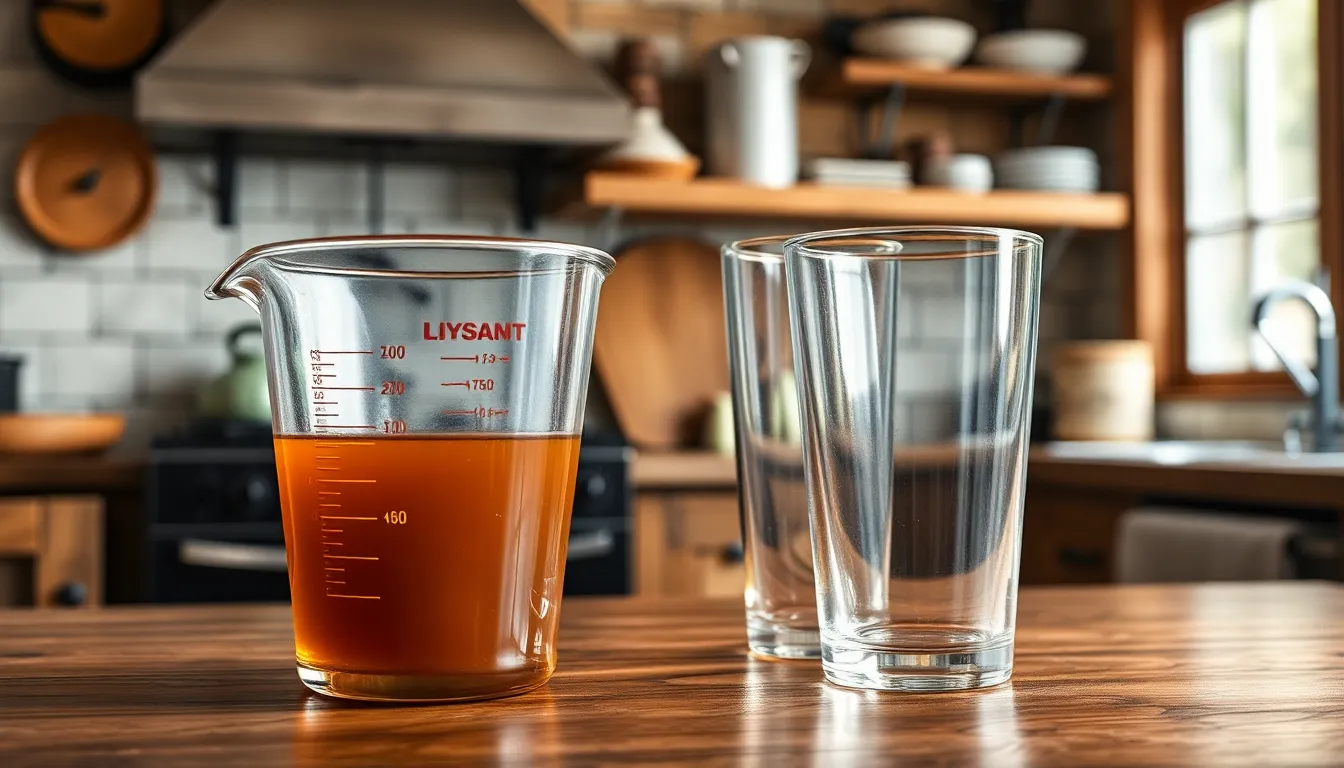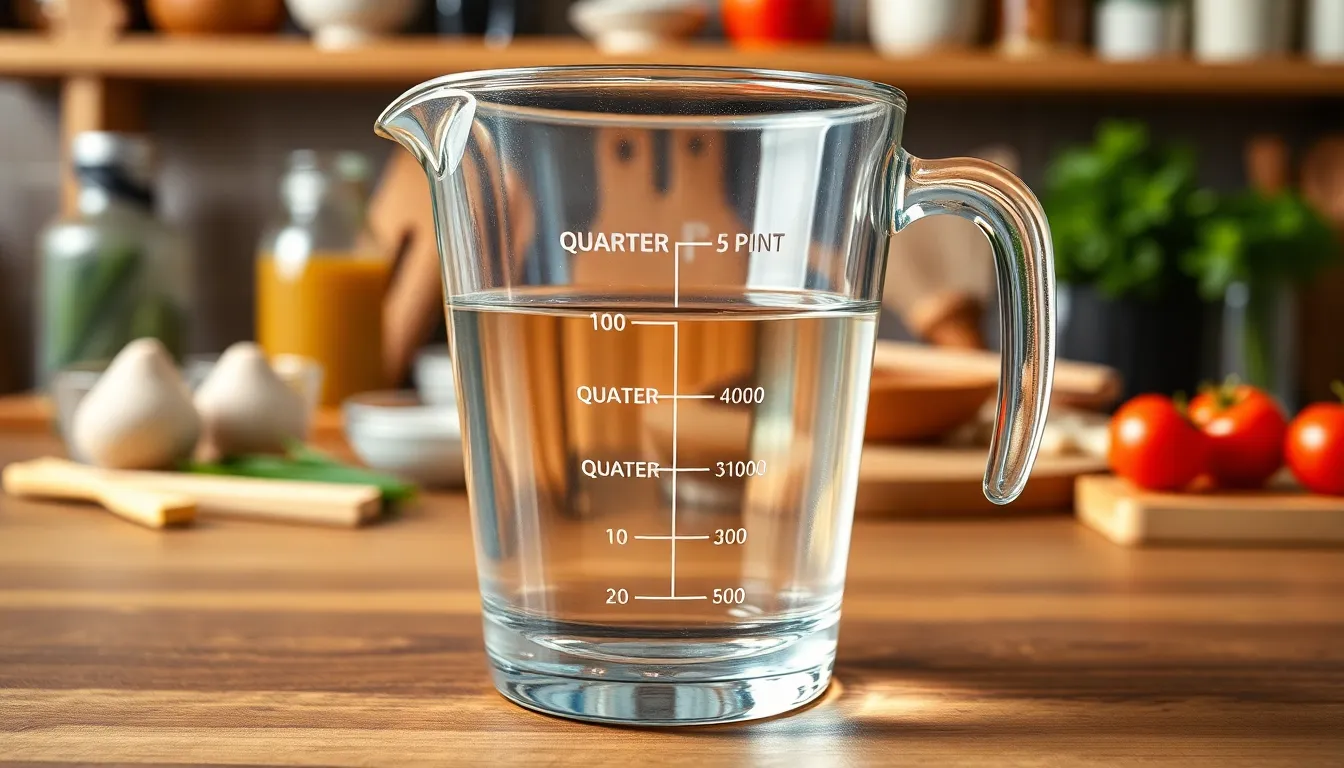Table of Contents
ToggleWhen it comes to measuring liquids, confusion can easily bubble up. Ever found yourself staring at a recipe that calls for a quart, wondering if you should grab a pint or two? Don’t worry, you’re not alone! The world of measurements can feel like a math test you didn’t study for.
Understanding Liquid Measurements
Measuring liquids often leads to confusion, especially when quart and pint conversions arise. A quart equals 2 pints, which simplifies cooking and baking tasks. Knowing this basic conversion helps clarify measurements in various recipes.
Common liquid measurements include gallons, quarts, pints, and cups. Each unit serves a distinct purpose, emphasizing the importance of accuracy. For instance, a gallon contains 4 quarts, so understanding these relationships can streamline food preparation.
Often, recipes use pints for smaller quantities, making it essential to visualize these conversions. When a recipe lists ingredients in quarts, simply multiplying by 2 provides the necessary pints. Familiarity with these measurements ensures confidence while cooking.
Utilizing a conversion chart can also support quick calculations. Many online resources display various liquid measurements, aiding in recipe adjustments. Keep in mind that consistent practice reinforces understanding.
Visual aids, such as measuring cups and dedicated kitchen tools, enhance liquid measurement accuracy. When possible, measure directly in the required unit to minimize errors. Adopting this approach elevates skills in the kitchen, eliminating guesswork.
People frequently encounter these measurements in everyday cooking. Whether it’s making soups, sauces, or beverages, knowing how many pints in a quart eases preparation. Ultimately, mastering liquid measurements simplifies cooking ventures, leading to better outcomes in any kitchen.
The Basics of Quarts and Pints

Understanding quarts and pints helps simplify measurements in cooking. Knowing these definitions clarifies the relationship between both units.
Definition of a Quart
A quart represents a volume measurement equal to 32 fluid ounces. In the United States, quarts often appear in recipes for liquids such as milk or broth. It forms part of the larger gallon measurement, where 1 gallon consists of 4 quarts. This equivalence streamlines conversions. For those cooking, visualizing a quart as 4 cups can aid in accurate measurement. When preparing larger batches of food, quarts serve as a practical unit to gauge ingredients efficiently.
Definition of a Pint
A pint signifies a volume measurement of 16 fluid ounces. In culinary contexts, pints frequently apply to beverages like beer or milk. Each pint equals 2 cups, making conversions straightforward. Notably, the pint measurement often appears in various recipes, especially in baking. Increasing awareness of pints enhances clarity when adjusting serving sizes. Mastering the pint further supports successful cooking endeavors by facilitating precise ingredient measurements.
The Conversion Factor
Understanding the conversion factor between quarts and pints helps simplify measurements in cooking. A quart holds the same volume as 2 pints.
How Many Pints in a Quart?
Each quart translates to exactly 2 pints. This equivalence is crucial when following recipes that switch between these two units. For instance, if a recipe calls for 1 quart of stock, knowing this equals 2 pints allows for precise measurement, ensuring optimal results in dishes.
Example Conversions
Exploring other liquid measures highlights the importance of conversions. In addition to 1 quart equaling 2 pints, 1 quart equals 32 fluid ounces. Similarly, 1 pint equals 16 fluid ounces. Thus, converting between different measurements supports accuracy, particularly when adjusting ingredient quantities based on serving sizes or batch scaling.
Practical Applications
Understanding liquid measurements proves beneficial in various scenarios. Accurate measurement in cooking and baking ensures consistency and quality in dishes. Many recipes specify ingredients in quarts or pints, making the conversion crucial. When adapting recipes, knowing that 1 quart equals 2 pints simplifies calculations. For example, if a recipe calls for 4 pints of broth, recognizing this equals 2 quarts aids in ingredient preparation. Using measuring cups specifically designed for liquid measurements enhances precision, reducing the risk of errors.
Beverage measurements also rely on clear distinctions between quarts and pints. Many beverages, such as beer or milk, often come in pint servings. A typical pint contains 16 fluid ounces, while a quart holds 32 fluid ounces. Understanding these conversions helps in estimating servings for gatherings or parties. For instance, purchasing a quart of a beverage translates to servings for 2 people if they each consume a pint. This knowledge improves planning, ensuring adequate quantities for social events.
Conclusion
Understanding the relationship between quarts and pints is vital for anyone who enjoys cooking or baking. With a quart equaling 2 pints, this simple conversion can significantly streamline meal preparation. By familiarizing oneself with these measurements and utilizing tools like measuring cups or conversion charts, individuals can enhance their culinary skills and ensure accuracy in their recipes.
This knowledge not only simplifies cooking but also boosts confidence in the kitchen. Whether it’s preparing a family meal or hosting a gathering, mastering liquid measurements paves the way for delicious outcomes and enjoyable cooking experiences.




